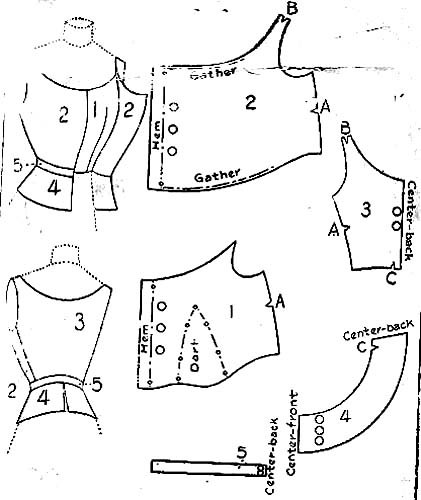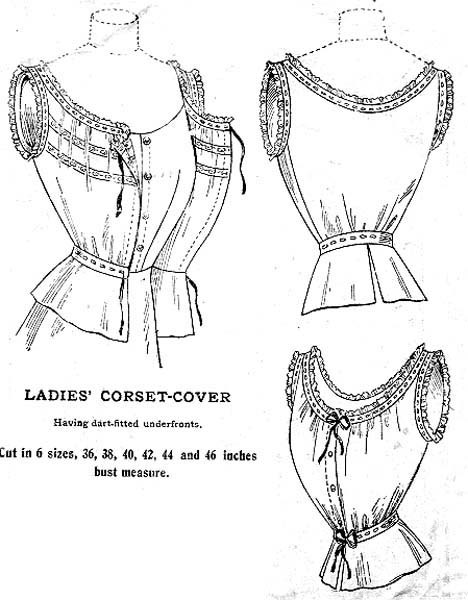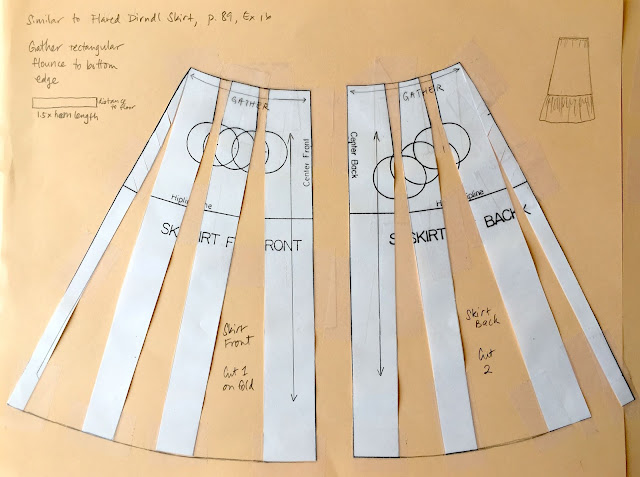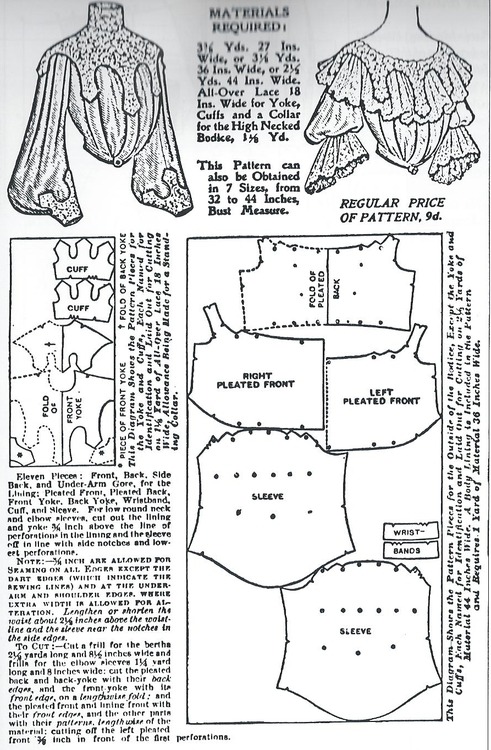In Canada College fashion department classes, besides the regular homework and the final outfit (of which the shirtwaist is the top half), we usually have to also turn in a lab garment. This is just another full outfit (covering an entire dress form, so a top and a skirt, or a dress) that demonstrates the skills we are learning, so we have to include the quarter- and full-scale patterns with the garments to show how we manipulated the basic sloper. At first, I had grand plans to make a tailored jacket to go on top, but that would 1) not be a complete outfit covering the dress form, and 2) take more time than I have to do it well. I think I'm going to save that for when I take Advanced Tailoring at some point in the future. In the interest of making a related but faster/easier lab garment, I decided to make a corset cover (basically, a sleeveless top that goes over the corset to disguise the hard lines of its edges) and a petticoat.
 |
| From here. |
I'm so glad that there are a lot of images floating around Pinterest that show pattern pieces or drafts for how to make a corset cover; that made it easy to manipulate the sloper to "match" the historical pieces. I also looked at a lot of extant corset covers (thank you to the Met for allowing me to just search "corset cover" and not the usual generic "undergarments" because that really made it a lot easier than having to sort through thousands of other kinds of undergarments) to get an idea for what kinds of variations were permissible. You know, so that I could then ignore them and do my usual "ehh, that's close enough" thing. I shifted the bust dart to the waist and then converted that dart to gathers, and converted the back darts to gathering at the neckline. The peplum was made by putting together the top sections of the skirt sloper to take out the darts, almost like making a skirt yoke, so as to keep it low profile when tucked into the petticoat.
 |
| Quarter-scale pattern work. |
 |
| The finished corset cover. |
 |
| The back! Compare to this one from The Met, which is looser. |
The front closes with buttons, plus a hook and bar at the waist and a ribbon at the top. I decided to go Bernadette Banner and make hand-worked buttonholes...and let's just say that it's a good thing these will be under the shirtwaist. I still enjoyed the process more than making machine buttonholes, though, so it was still a net positive.
For the petticoat, I referenced the excellent material collected on Sew Historically and ended up doing what were basically curved trapezoids that gathered at the waist with a drawstring, with the ruffle being just a long rectangle gathered to the hem of the trapezoids. Ideally I would have had lace at the ruffle seam, and probably some tucks to help hold out the ruffle more, but in the interest of time, I left it plain.
 |
| I'm glad the historically accurate finish for the waist is so simple: slap on some bias tape to make a casing, and no need to even add a placket or closure to the opening. |
 |
| I used the rolled-hem foot on my machine to finish all the yards of hem. |
Since I don't have an S-bend corset, nor do I plan on getting one just for this ridiculous little project, it was imperative that I have a bustle pad to help get closer to the right silhouette. I just sketched out a little curved semi-circle shape like the one in this historical patent, cut it out of muslin and then stuffed it with Costco bear innards (one of my students gave one to SHB#1 without my prior knowledge/consent, so I've been slowly deflating it every time I need stuffing) and sewed on a piece of twill tape for a waist tie. Once again, Bernadette Banner's video was very helpful, even if I mostly didn't do what she did.
My hair has gotten ridiculously long (I haven't cut it since getting pregnant with SHB#2, which was three years ago, so it's down to the small of my back) so I figured I would give the Gibson girl hairstyle a try. I used the black pudding plushie I made nine years ago as a hair rat, then used oh, a hundred or so bobby pins to secure my hair over it. I think it worked fairly well for a spur of the moment hairstyle!
So here's what it all looked like together:
 |
| Oh hai, I'm the Chinese Camille Clifford knock-off. |
 |
| My hair was falling down in the back. Looks like a hundred bobby pins wasn't enough. |
 |
| Nice rounding out of the bum area provided by the little bustle pad! |
And why are all these pictures so awkwardly cropped? Because the small human beings were entranced by Mommy's funny hair and clothes and were hovering around.
Summary
Pattern: Self-drafted, based on historical pattern pieces/drafting directions
Fabric: For the corset cover, I used a leftover piece of thrifted white cotton sateen sheet (the rest of the sheet went to a Princess Leia costume for a friend). I dyed it with coffee to get it match the lace. The petticoat is a (unfortunately) polyester microfiber sheet in a pale mint green that somebody gave me "because you like sewing with sheets, right?" I used it because it fits the Slytherin color scheme, and all my other sheets were too patterned or earmarked for other projects already.
Notions: Three very anachronistic clear buttons for the corset cover, and a hook for the waist closure. I ran out of bars so I made a thread bar for the first time! The lace for the top is from a vintage fair I went to eight years ago, so I'm glad I finally got a chance to use it. The bias tape for the petticoat drawstring casing is from my school librarian's neighbor's destash, and the drawstring itself is cut off of an old bathrobe.
Hours: A couple hours for drafting, a couple for cutting out, 1.5 hours for sewing the petticoat, and probably four for the corset cover. Total: let's just say 14.
How accurate is it? The corset cover should be made with thinner fabric and probably should have a drawstring at the waist, too. The petticoat should probably be made with stiffer fabric and have more lace, tucks, and ruffles.
Total cost: The fabrics were all stash, given to me, or leftover from other projects, so I'm going to say $5 when counting the little bit of lace, cotton sheet, and buttons. And once again, I didn't buy anything new!
Final thoughts: The corset cover is a little tight in the armscye and bust area, so I'm thinking of going in and adding a little triangular wedge at the side seam. Again, we're theoretically not designing garments for ourselves, but for a mannequin, so I'm not surprised, but I would like it to be a little more comfortable to wear. I think once I do that and get a blousier fit, I'll be pretty pleased with the overall "ooh, I'm in my historical undahwears!" look though!
 |
| Old-timey filter! |



















